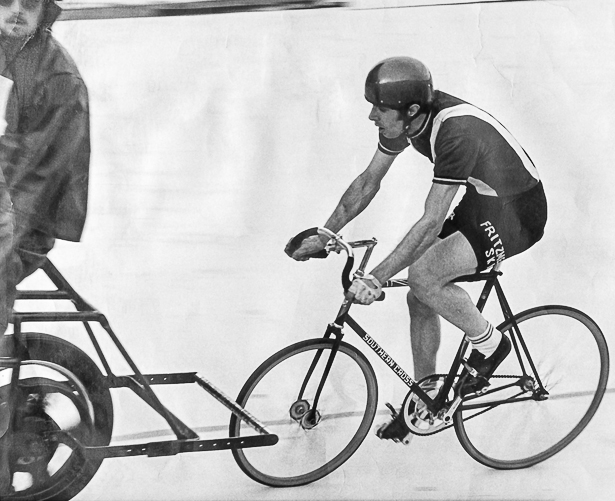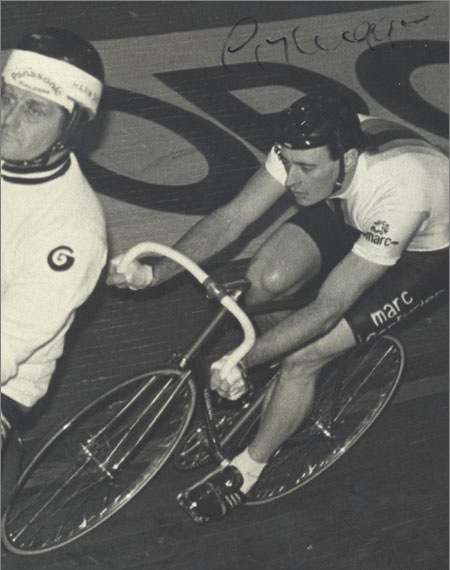We thought that you might like to hear what it was like to be a Six Day runner back in a time when the Sixes meant more than they do now. The big road stars were in action and it was full houses all across Europe – particularly in Germany. John Purser is the man’s name and here’s his tale.
It’s Lombardia and the Trossachs today; that means just one thing – it’s almost time for the Six Days. It’s looking like VeloVeritas won’t be emptying any ‘you know what’ pails this year, with contracts and riders still not inked-in – but you never know…
We will be at Gent, however – my liver gave a twinge just there – as fans.
De Karper, The Hotel Adoma, Bar Vivaldi, the ‘cross up at Koksijde – I can’t help but smile at the thought.

How did you get involved in the Sixes, John?
“I knew Keith Robbins of BeeKay products; they did all the PR material for Ron Webb who promoted the London Six Days – that was my road in.
“The Sixes were held on a three-penny bit of a plywood track jammed into Wembley Arena – before that there was at least one held at Earl’s Court.”
How many did you do?
“I did half-a-dozen in London. Initially I was helping Keith with the signs and PR stuff but then I got the job of organising the score board – right above Dave Duffield’s head. (Duffield was ‘speaker’ for the Six, back then.) I saw how it all worked and decided I wanted to be a ‘runner.’
“Dieter Kemper was the first rider I worked with – he was a good guy who I still keep in touch with.
“Hugh Porter saw me at the Six, I knew him from his days with Wolverhampton Wheelers, and I began to look after him, too – which I did for three years.
“He told the continental guys that I could do the job and they were happy to go with his recommendation – riders like Rik Van Linden. During the time I worked for Viscount Cycles I also had to take care of their PR at the race.
“The soigneur I worked for was Leen Jannsen; he was actually a fish wholesaler and owned holiday flats in Knokke or one of the other Belgian North Sea holiday resorts.
“We had four teams, eight riders, he did most of the massage and the riders were happy to use me – anything to keep the costs down.”
How were the good guys and bad guys among the riders?

“Klaus Bugdahl wasn’t the friendliest guy; Dieter Kemper was a good guy, so were Barry Hoban and Romain de Loof.
“Albert Fritz could be a bit difficult and Hughie Porter could be a bit moody but most were OK with you once they saw that you knew what you were doing.
“Leen wanted me to give up my day job in the winter and do all the continental Six Days with him – but it was at the time of the petrol crisis, there was a lot of uncertainty and I didn’t want to go and live the gypsy life…”
Did you come across Maurice Burton?
“He rode as an amateur in one or two of the races – they did a one hour chase.
“A lot of the amateurs who rode were part of what I called, ‘The South London Mafia’ – all on their Geoffrey Butler bikes.
“I remember that he did experience a lot of prejudice though – and he did stand out like a sore thumb on the track because of his colour.”
Gary Wiggins?
“He was one of the amateur riders, too – I only knew him from the Six Days; but he just seemed like a hard working Aussie.
“It’s a shame he’s not around to tell his side of the story; but you have to feel sorry for Bradley – his childhood was stolen. But back then Gary was under a lot of strain to make money to survive.
“Graeme Gilmore, another Aussie was on the Six Day scene back then – but he disappeared back to Tasmania.
“The story was that the Belgian tax authorities were on his trail – but someone within their organisation was a cycling fan and tipped Gilmore off and he fled.”
And you looked after Barry Hoban?

“He rode twice that I recall and I looked after him both times – he was Britain’s best rider so he was one of the stars of the show along with Post and Sercu.
“He always looked the part, his bikes were immaculate and he was fastidious about his clothing and shoes.
“He was a real pro who knew how to look after himself and appreciated the work you did for him.”
What did you enjoy most about being a runner?
“Watching the madisons – and being paid too!
“But you had to have eyes in the back of your head, watching your riders all the time in case there was a crash – but luckily I didn’t experience that too many times.
“I remember Hugh Porter crashed and cracked his wrist, he went to the local Accident & Emergency clinic and had them plaster it up to suit his handlebars. He was riding with Dieter Kemper who was the consummate madison rider – on a par with Fritz, I’d say and Fritz was a real Six Day ace.
“Dieter showed Hugh how to best position himself on the track for the changes because with his damaged wrist he couldn’t really give a strong sling.
“They were all pros together, the objective wasn’t to frighten anyone, it was to create a show – you were all workmates and if someone wasn’t cooperating then they were told!
“People used to say to me; ‘it’s all fixed, isn’t it?’ But you only got a contract if you could perform and you had to be serious about your job.
“First and foremost it was a show – Sercu and Post could probably have won them all but as part of that show, ‘you can’t win ‘em all!’”

What was your least favourite part?
“There was an awful lot of cleaning and washing kit which wasn’t the most fun; I’d been living the bachelor life and you got your mum to do stuff like that!
“Then there was the pail – they didn’t just pee in it back then, if you know what I mean . . .”
Did you get paid OK?
“I had no problems, Hugh Porter was supposed to be mean but he always paid me on the spot.
“The Germans were very straightforward to deal with; and they’d give you nice mementos like shorts, jerseys, track tops – they knew that stuff like that meant a lot to you as an amateur cyclist.”
Did any of your riders have their ‘rituals?’
“No, not that I came across; but now and again they’d fancy some special food – maybe a bunch of grapes – so I’d jump on my bike and pedal off and get them.”
Which riders impressed you most?
“You couldn’t help but be impressed with Sercu; Sigi Renz could do everything – chase, sprint, Derny and Albert Fritz and Dieter Kemper were both ‘aces’ – top all round Six Day riders.”
Why quit?

“I did my last one in 1975; I was working for Viscount Cycles at the time but they went bust.
“It meant I came out of that world – my job at Viscount was pretty average but I got a lucky break and my next job gave me the opportunity to travel.
“I was head-hunted and ended up working in Saudi and doing a lot of travelling.”
Do you still keep in touch with the Six Days?
“I go over to the continent when I can – I worked with a German company in Dortmund and always tried to get the board meetings to coincide with the Six Day.
“Watching it I was a bit like one of those old guys, Statler and Waldorf, in The Muppets – ‘well, it’s not like my day, but it’s not bad, in fact, it’s pretty good!’
“The last one I was at was Bremen and up on the fence they have the list of previous winners – Gary Wiggins name is up there.
“You know, for all the negative stuff you hear about the man, he was one capable Six Day rider.”
Let’s hope Gary is resting in peace and many thanks to John for sharing his reminiscences with us.



